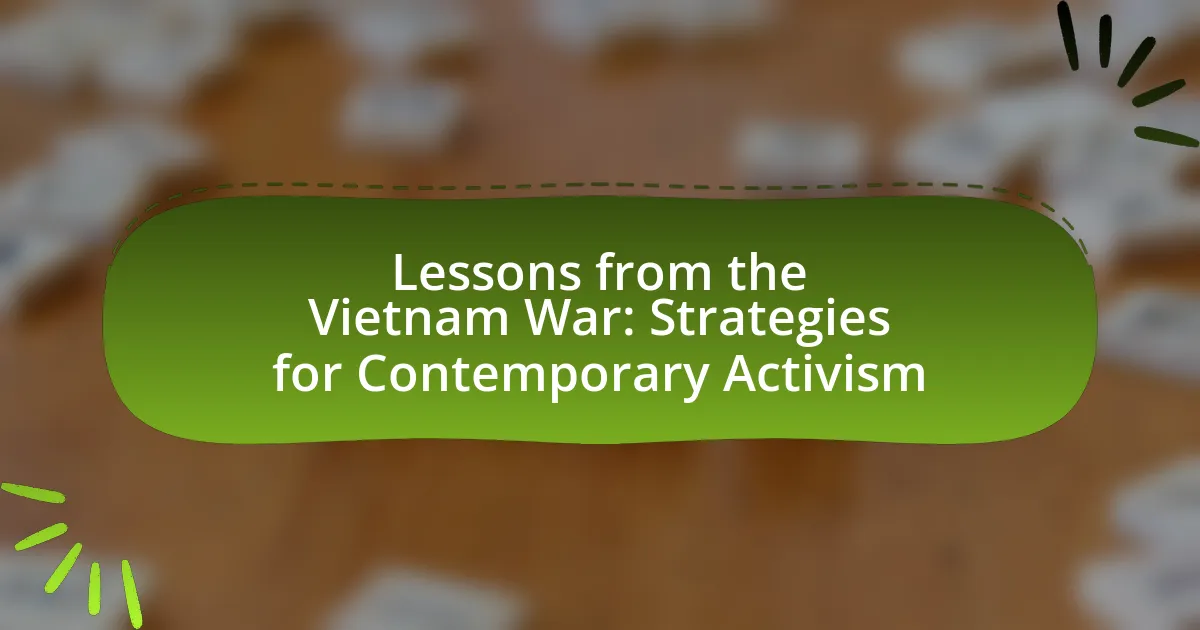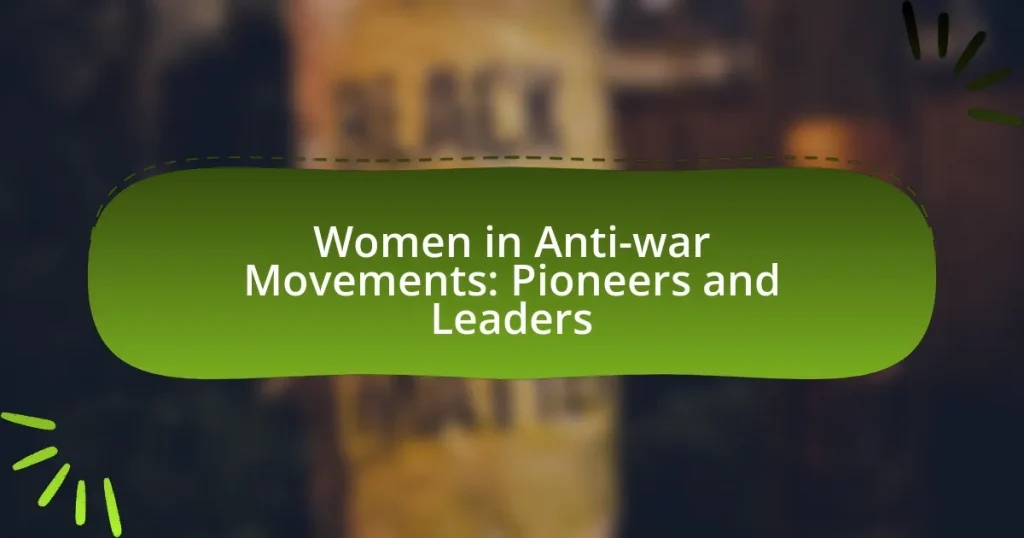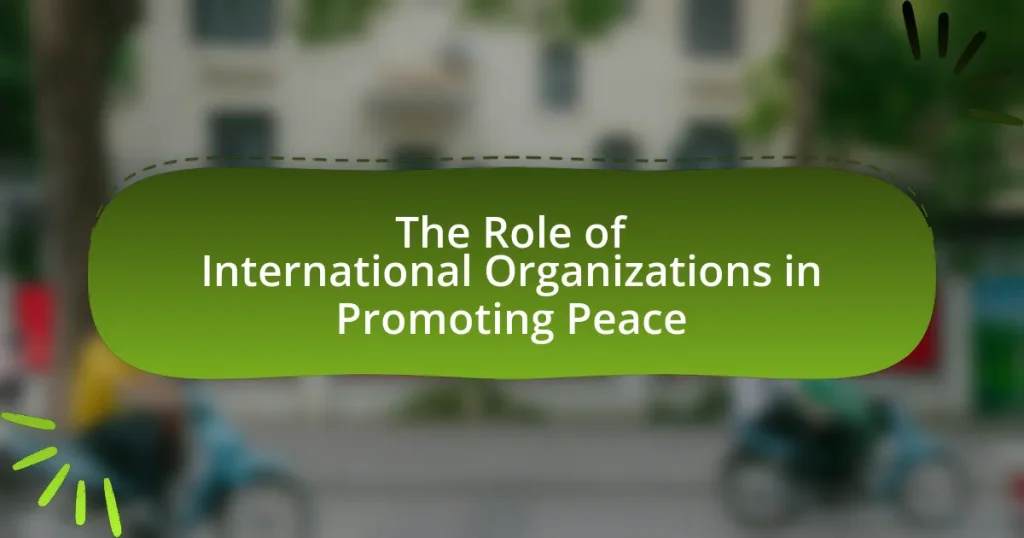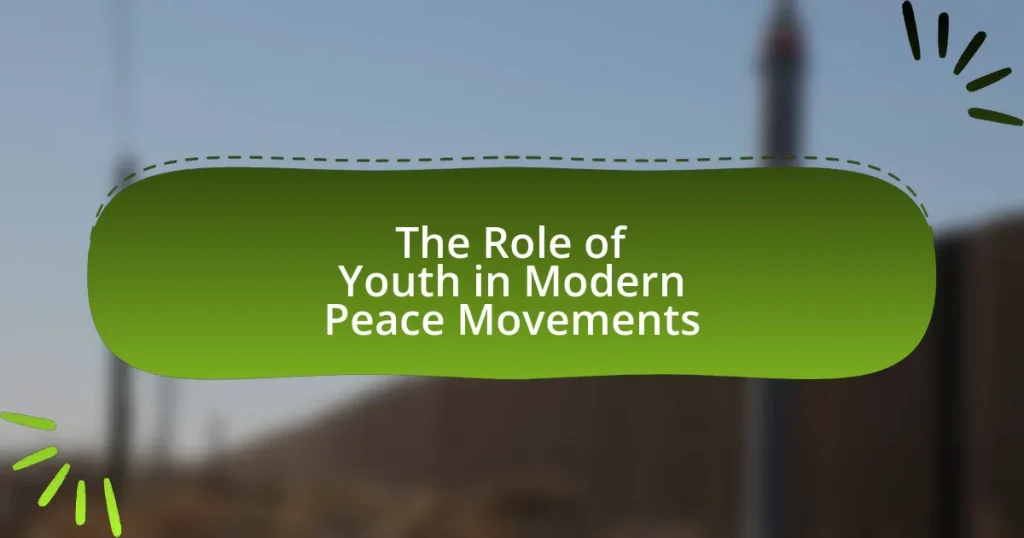The article focuses on the key lessons from the Vietnam War that can inform contemporary activism, emphasizing the significance of grassroots mobilization, media influence, and sustained commitment to social causes. It explores how the Vietnam War shaped public perception of activism, highlighting the role of media in shaping narratives and mobilizing support. Additionally, the article discusses effective strategies used during the anti-war movement, such as coalition-building and grassroots organizing, while also addressing mistakes made by activists that diluted their impact. Finally, it outlines practical steps modern activists can take to apply these historical lessons to current social movements, including leveraging technology and fostering inclusive coalitions.
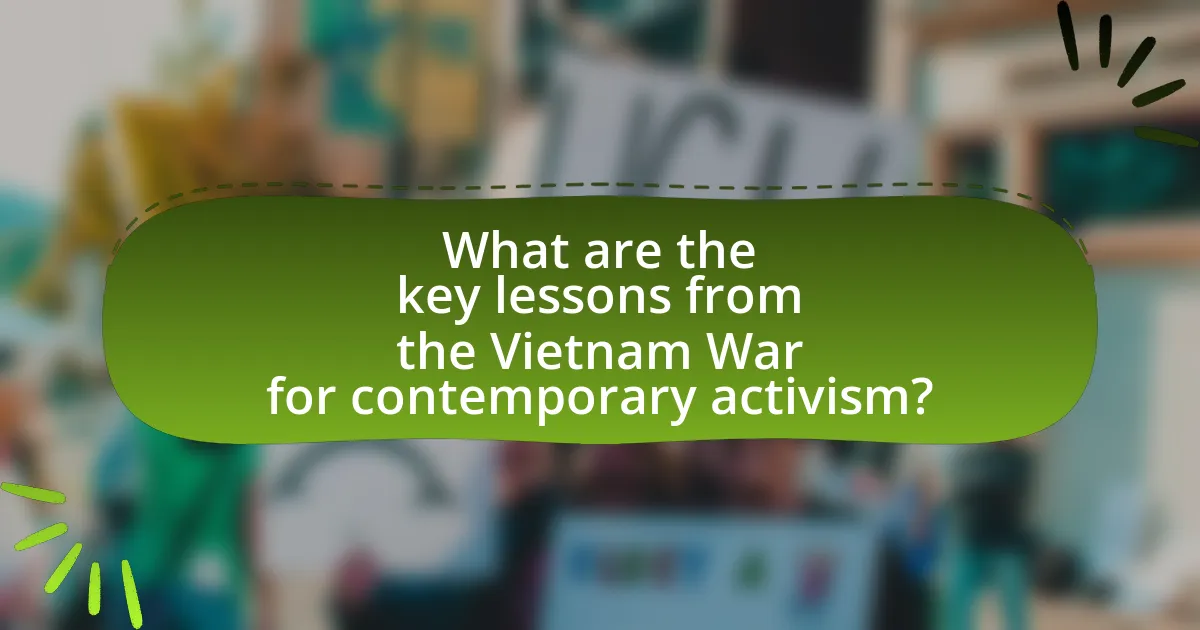
What are the key lessons from the Vietnam War for contemporary activism?
The key lessons from the Vietnam War for contemporary activism include the importance of grassroots mobilization, the power of media in shaping public perception, and the necessity of sustained commitment to a cause. Grassroots mobilization was evident as anti-war protests grew from small gatherings to massive demonstrations, illustrating that collective action can influence political decisions. The media played a crucial role, with televised coverage of the war impacting public opinion and demonstrating how effective communication can galvanize support for social movements. Additionally, the long-term commitment of activists, as seen in the persistence of anti-war efforts despite setbacks, underscores the need for resilience and adaptability in contemporary activism. These lessons highlight strategies that remain relevant for current movements advocating for social change.
How did the Vietnam War shape public perception of activism?
The Vietnam War significantly shaped public perception of activism by highlighting the power and impact of grassroots movements. Activism during this period, particularly anti-war protests, mobilized millions of Americans and demonstrated that collective action could influence government policy, as seen in the widespread demonstrations that peaked in the late 1960s and early 1970s. The media coverage of these protests, including events like the Kent State shootings in 1970, further amplified public awareness and support for activist causes. This era established a precedent for future movements, illustrating that organized dissent could challenge prevailing narratives and lead to substantial social and political change.
What role did media play in influencing public opinion during the Vietnam War?
Media played a crucial role in influencing public opinion during the Vietnam War by providing graphic coverage of the conflict, which shifted perceptions about the war. Television broadcasts, particularly the evening news, brought images of combat and civilian casualties into American living rooms, leading to increased anti-war sentiment. For instance, the Tet Offensive in 1968 was widely televised, contradicting official government claims of progress and contributing to a decline in public support for the war. Additionally, print media, such as newspapers and magazines, published critical articles and photographs that highlighted the war’s brutality, further galvanizing opposition. This media coverage was instrumental in shaping public discourse and mobilizing protests, demonstrating the power of media as a tool for activism and public engagement during this period.
How can modern activists leverage media to shape narratives today?
Modern activists can leverage media to shape narratives today by utilizing social media platforms to disseminate information rapidly and engage with a broader audience. Social media allows activists to bypass traditional media gatekeepers, enabling them to share their messages directly with the public. For instance, during the Black Lives Matter movement, hashtags like #BlackLivesMatter went viral, mobilizing support and raising awareness about systemic racism. This demonstrates how digital platforms can amplify voices and foster community engagement, effectively altering public perception and driving social change.
What strategies were effective for anti-war movements during the Vietnam War?
Effective strategies for anti-war movements during the Vietnam War included mass protests, grassroots organizing, and the use of media to raise awareness. Mass protests, such as the 1969 Moratorium to End the War in Vietnam, mobilized millions and demonstrated widespread opposition to the war. Grassroots organizing involved local groups forming coalitions to coordinate actions and spread anti-war messages, significantly increasing participation and engagement. The strategic use of media, including television coverage of protests and graphic images of the war’s impact, played a crucial role in shaping public opinion and increasing pressure on the government to withdraw troops. These strategies collectively contributed to a significant shift in public sentiment and policy regarding the Vietnam War.
Which grassroots organizing techniques were utilized by activists?
Activists utilized several grassroots organizing techniques, including community mobilization, coalition building, and direct action. Community mobilization involved engaging local populations to raise awareness and encourage participation in activism, exemplified by the Vietnam War protests where citizens organized rallies and teach-ins. Coalition building was crucial as activists formed alliances across diverse groups to amplify their voices and resources, as seen in the collaboration between anti-war groups and civil rights organizations. Direct action, such as sit-ins and marches, served to disrupt normalcy and draw media attention, effectively highlighting their cause and demanding change. These techniques were instrumental in creating a unified front against the Vietnam War, demonstrating the power of grassroots efforts in influencing public opinion and policy.
How did coalition-building impact the success of anti-war efforts?
Coalition-building significantly enhanced the success of anti-war efforts by uniting diverse groups with a common goal, thereby amplifying their collective voice and influence. For instance, during the Vietnam War, organizations such as Students for a Democratic Society and the National Mobilization Committee to End the War in Vietnam collaborated, which allowed them to pool resources, share strategies, and mobilize larger crowds for protests. This unity not only increased visibility but also demonstrated widespread opposition to the war, influencing public opinion and political discourse. The effectiveness of coalition-building is evidenced by the substantial protests in 1969, where over 250,000 demonstrators gathered in Washington, D.C., showcasing the power of a united front in advocating for peace.
What mistakes were made by activists during the Vietnam War?
Activists during the Vietnam War made several significant mistakes, including failing to unify their messaging and alienating potential supporters. The fragmentation of the anti-war movement led to competing factions, which diluted their overall impact and made it difficult to present a cohesive front against the war. For instance, the division between more radical groups and moderate activists created confusion and weakened public perception of the movement. Additionally, some activists resorted to extreme tactics, such as violent protests, which alienated mainstream Americans and undermined the legitimacy of their cause. This is evidenced by the backlash against events like the 1968 Democratic National Convention protests, which were marked by violence and chaos, leading to a negative public response.
How did miscommunication affect the anti-war movement’s effectiveness?
Miscommunication significantly undermined the effectiveness of the anti-war movement by creating divisions among activists and diluting their message. For instance, differing interpretations of the movement’s goals led to fragmented efforts, with some groups focusing on immediate withdrawal from Vietnam while others emphasized broader social justice issues. This lack of a unified message weakened public support and made it easier for opponents to dismiss the movement. Additionally, misinformation about events, such as the Tet Offensive in 1968, caused confusion and misalignment in strategy, further hampering the movement’s ability to mobilize effectively. The result was a less cohesive and impactful campaign against the war, ultimately limiting its success in influencing policy change.
What lessons can be learned from the failures of certain strategies?
Failures of certain strategies, particularly in the context of the Vietnam War, highlight the importance of understanding local dynamics and the limitations of military power. The U.S. military’s reliance on overwhelming force without adequate cultural and political understanding led to significant setbacks, demonstrating that strategies must be adaptable to the specific context of the conflict. For instance, the Tet Offensive in 1968 revealed that despite military superiority, the U.S. could not achieve its objectives due to a lack of insight into the Vietnamese people’s motivations and resilience. This underscores the necessity for contemporary activists to prioritize grassroots engagement and local knowledge over top-down approaches, ensuring that strategies are informed by the realities on the ground.

How can the lessons from the Vietnam War be applied to current social movements?
The lessons from the Vietnam War can be applied to current social movements by emphasizing the importance of grassroots organizing, effective communication, and the power of public opinion. Grassroots organizing was crucial during the Vietnam War, as it mobilized large segments of the population against the war, demonstrating that collective action can influence political decisions. Effective communication, particularly through media, played a significant role in shaping public perception and rallying support, as seen with the anti-war protests that gained national attention. Furthermore, the Vietnam War highlighted the necessity of addressing moral and ethical concerns to resonate with a broader audience, which current social movements can leverage to gain traction and support. For instance, the Black Lives Matter movement utilizes social media to amplify its message and mobilize supporters, similar to how anti-war activists used print and broadcast media to spread their message.
What parallels exist between the Vietnam War protests and today’s activism?
Parallels between the Vietnam War protests and today’s activism include the use of grassroots organizing and social media to mobilize large groups for a common cause. During the Vietnam War, protests were organized by coalitions of students, veterans, and civil rights activists, which effectively raised awareness and influenced public opinion against the war. Similarly, contemporary activism, such as the Black Lives Matter movement, utilizes social media platforms to organize protests, share information, and amplify voices, demonstrating the power of collective action. Both movements also highlight the importance of addressing systemic injustices, with Vietnam War protests focusing on anti-imperialism and today’s activism addressing issues like racial inequality and climate change. These similarities underscore the enduring strategies of mobilization and advocacy in social movements across different eras.
How do contemporary movements reflect the strategies used in the Vietnam War?
Contemporary movements reflect the strategies used in the Vietnam War through their emphasis on grassroots organizing, media engagement, and nonviolent protest. Grassroots organizing, similar to the anti-war efforts of the 1960s, empowers local communities to mobilize and advocate for change, as seen in movements like Black Lives Matter and climate activism. Media engagement, a critical component during the Vietnam War that shaped public perception, is mirrored today in how movements utilize social media to amplify their messages and reach wider audiences. Nonviolent protest tactics, such as sit-ins and marches, echo the strategies employed by Vietnam War protesters, demonstrating a commitment to peaceful resistance while drawing attention to social injustices. These parallels illustrate how contemporary movements adopt and adapt historical strategies to effectively challenge systemic issues.
What unique challenges do modern activists face compared to those in the Vietnam War?
Modern activists face unique challenges such as the overwhelming influence of social media, which can both amplify their message and lead to misinformation. Unlike activists during the Vietnam War, who relied on traditional media and grassroots organizing, contemporary activists must navigate a digital landscape where information spreads rapidly, often without verification. This environment can create echo chambers that distort public perception and complicate coalition-building efforts. Additionally, modern activists contend with sophisticated surveillance technologies and data privacy concerns that were not present during the Vietnam War, making it harder to organize and mobilize without risking personal safety or privacy.
How can activists today utilize technology to enhance their efforts?
Activists today can utilize technology to enhance their efforts by leveraging social media platforms for awareness and mobilization. Social media enables activists to reach a global audience quickly, facilitating the dissemination of information and rallying support for causes. For instance, the #MeToo movement gained significant traction through platforms like Twitter and Facebook, illustrating how digital communication can amplify voices and foster community engagement. Additionally, tools such as crowdfunding websites allow activists to raise funds for initiatives, while data analytics can help identify trends and target specific demographics effectively. These technological advancements provide activists with powerful resources to organize, inform, and inspire action on pressing social issues.
What platforms are most effective for mobilizing support in current movements?
Social media platforms, particularly Facebook, Twitter, and Instagram, are the most effective for mobilizing support in current movements. These platforms enable rapid dissemination of information, facilitate community building, and allow for real-time engagement with supporters. For instance, during the Black Lives Matter movement, Twitter was instrumental in spreading awareness and organizing protests, with hashtags like #BlackLivesMatter trending globally. Additionally, Facebook groups have been used to coordinate local events and foster discussions among activists, demonstrating their utility in grassroots mobilization.
How can social media be used to amplify activist messages?
Social media can amplify activist messages by providing a platform for rapid dissemination and engagement with a wide audience. Activists can utilize social media to share information, mobilize supporters, and create viral campaigns that raise awareness about their causes. For instance, the #BlackLivesMatter movement effectively used Twitter and Instagram to spread messages and organize protests, resulting in significant public engagement and media coverage. According to a Pew Research Center study, 69% of adults in the U.S. use social media, making it a powerful tool for reaching diverse demographics and fostering community support.
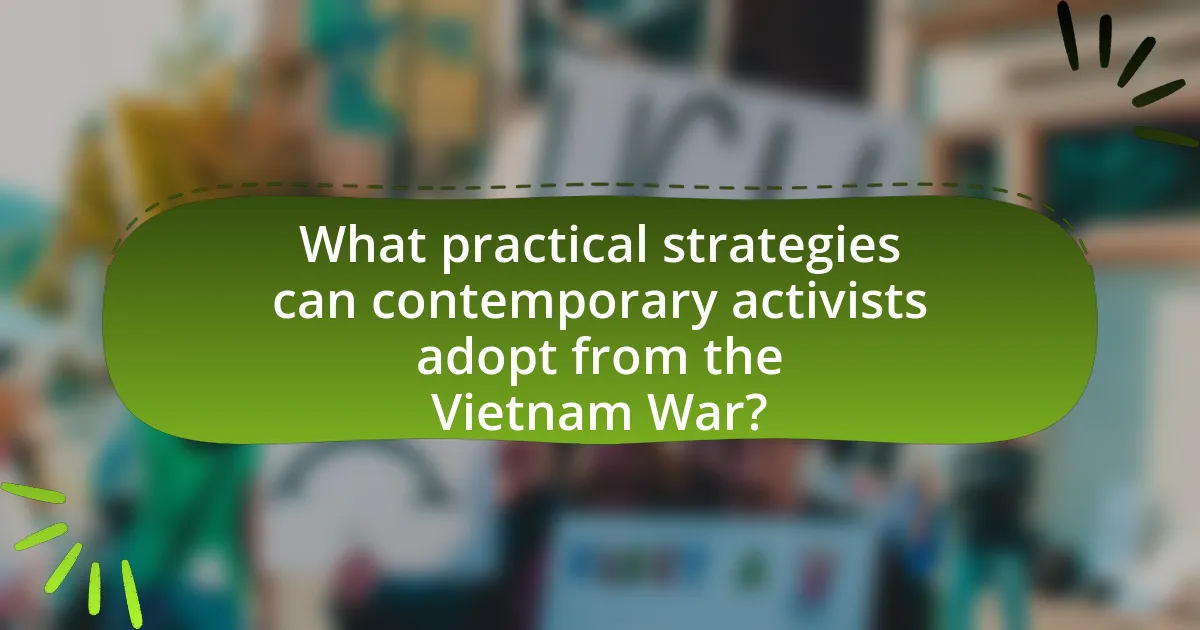
What practical strategies can contemporary activists adopt from the Vietnam War?
Contemporary activists can adopt grassroots mobilization and media engagement strategies from the Vietnam War. Grassroots mobilization was exemplified by the anti-war movement, which effectively organized protests and demonstrations, drawing large crowds and gaining public attention. For instance, the 1969 Moratorium to End the War in Vietnam mobilized millions across the United States, showcasing the power of collective action. Additionally, activists can learn from the use of media, as the Vietnam War was one of the first conflicts extensively covered by television, influencing public perception. The graphic imagery and reporting of the war’s impact galvanized opposition and highlighted the importance of narrative in activism. By leveraging social media and traditional media today, contemporary activists can similarly shape public discourse and mobilize support for their causes.
How can activists effectively engage with diverse communities?
Activists can effectively engage with diverse communities by employing inclusive communication strategies and fostering genuine relationships. This involves actively listening to community members, understanding their unique needs, and tailoring messages that resonate with their cultural contexts. Research indicates that grassroots organizing, which prioritizes local voices and perspectives, enhances community trust and participation. For instance, the success of the Civil Rights Movement was largely attributed to its ability to mobilize diverse groups through localized efforts and culturally relevant messaging. By prioritizing collaboration and respect for cultural differences, activists can build stronger coalitions and drive meaningful change.
What methods can be used to build inclusive coalitions?
To build inclusive coalitions, methods such as fostering open communication, ensuring diverse representation, and establishing shared goals are essential. Open communication allows for the exchange of ideas and concerns, which helps to build trust among coalition members. Ensuring diverse representation involves actively including voices from various backgrounds, which enhances the coalition’s ability to address a wider range of issues and perspectives. Establishing shared goals aligns the efforts of coalition members, creating a unified direction that encourages collaboration. These methods are supported by historical examples from the Vietnam War, where diverse groups united for a common cause, demonstrating the effectiveness of inclusive strategies in activism.
How can understanding local contexts improve activism efforts?
Understanding local contexts can significantly enhance activism efforts by ensuring that strategies are tailored to the specific cultural, social, and political dynamics of a community. When activists comprehend the unique challenges and values of a locality, they can craft messages and actions that resonate more deeply with the residents, thereby increasing engagement and support. For instance, during the Vietnam War, activists who understood the local sentiments and historical grievances were more effective in mobilizing communities against the war. This approach is supported by research indicating that localized strategies lead to higher participation rates and more sustainable movements, as seen in various grassroots campaigns that successfully addressed community-specific issues.
What are the best practices for sustaining long-term activism?
The best practices for sustaining long-term activism include building a strong community, maintaining consistent communication, and adapting strategies based on feedback and changing circumstances. A strong community fosters solidarity and support, which is essential for resilience; for example, organizations like the Student Nonviolent Coordinating Committee (SNCC) during the Civil Rights Movement thrived on grassroots involvement. Consistent communication keeps members informed and engaged, as seen in the anti-war movements of the Vietnam War era, where newsletters and meetings were vital for mobilization. Adapting strategies ensures relevance and effectiveness, evidenced by the shift in tactics from protests to lobbying in response to changing political landscapes. These practices collectively enhance the sustainability and impact of activism over time.
How can activists maintain momentum over time?
Activists can maintain momentum over time by consistently engaging their communities through regular communication, events, and updates on progress. This approach fosters a sense of belonging and urgency among supporters, which is crucial for sustained involvement. Historical evidence from the Vietnam War era shows that grassroots organizing and frequent mobilization efforts, such as protests and educational campaigns, kept public interest alive and pressured policymakers. For instance, the anti-war movement utilized media effectively to amplify their message, resulting in increased public awareness and participation, which ultimately influenced government decisions.
What role does self-care play in sustaining activist efforts?
Self-care is essential for sustaining activist efforts as it helps maintain mental and physical well-being, preventing burnout. Activists often face emotional and psychological stress due to their work, which can lead to decreased effectiveness over time. Research indicates that individuals who engage in self-care practices, such as mindfulness and regular physical activity, report higher resilience and better coping strategies, which are crucial for long-term commitment to activism. For instance, a study published in the Journal of Community Psychology highlights that self-care routines significantly enhance the sustainability of social movements by fostering a supportive community among activists.
What actionable steps can activists take to implement these lessons today?
Activists can implement lessons from the Vietnam War today by employing grassroots organizing, leveraging social media for awareness, and forming coalitions with diverse groups. Grassroots organizing allows activists to mobilize local communities effectively, as seen in the Vietnam War protests where local actions led to national movements. Utilizing social media platforms can amplify messages and reach wider audiences, similar to how anti-war activists used pamphlets and public demonstrations to spread their message. Forming coalitions with various organizations enhances resource sharing and strengthens advocacy efforts, reflecting the collaborative strategies used during the Vietnam War to unite different activist groups against a common cause.
